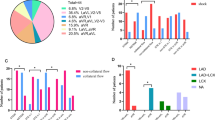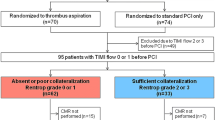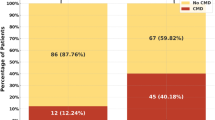Abstract
Background
It is assumed that patients with non-ST-elevation myocardial infarctions (NSTEMI) showing an infero- or posterolateral occluded culprit artery (OCA) during diagnostic angiography frequently elude standard 12-lead electrocardiogram diagnosis. In addition, coronary collaterals may have beneficial effects in patients with OCA.
Methods
We examined 448 consecutive NSTEMI patients within 72 h of symptom onset. All patients underwent early invasive angiography plus optimal medical therapy. We compared clinical characteristics and 30-days/6-month major adverse cardiovascular events (MACE) between patients with OCA and non-OCA. The secondary objective was to investigate the effect of angiographically visible coronary collaterals on 6-month MACE in patients with OCA.
Results
The angiograms revealed OCA in 130 (29%) of 448 patients. Patients with OCA showed more often infero- or posterolateral lesions (75 vs. 53%, p < 0.001) and more collaterals (57 vs. 8%, p < 0.001) compared with those with non-OCA. Patients with OCA had larger infarcts (peak CK-MB 2.1 ± 2.3 vs. 1.2 ± 1.1 μmol/L/s, p < 0.001), lower left ventricular ejection fraction (42 ± 21 vs. 48 ± 20%, p = 0.01), were more often revascularized (89 vs. 78%, p = 0.005), and had higher risk-adjusted 6-month MACE largely driven by its association with non-fatal reinfarctions (HR 2.16, 95% CI 1.04–4.50, p = 0.04). Patients with OCA and angiographically absent collaterals had significantly higher risk-adjusted 6-month MACE than those with OCA and angiographically visible collaterals (HR 1.96, 95% CI 1.02–3.76, p = 0.04).
Conclusions
Approximately one-fourth of patients with NSTEMI revealed OCA that was more frequently found in coronary arteries supplying the infero- or posterolateral myocardium. Patients with OCA had larger infarcts and more non-fatal reinfarctions than patients with non-OCA. Well-developed collaterals may limit the myocardial damage in these patients.



Similar content being viewed by others
Abbreviations
- ACE:
-
Angiotensin-converting enzyme
- ACS:
-
Acute coronary syndrome
- CABG:
-
Coronary arteries bypass graft
- CI:
-
Confidence interval
- CK:
-
Creatine kinase
- CK-MB:
-
Creatine kinase-myocardial band fraction
- cTNT:
-
Troponin T
- ECG:
-
Electrocardiogram
- HR:
-
Hazard ratio
- MACE:
-
Major adverse cardiovascular events
- MI:
-
Myocardial infarction
- NSTEMI:
-
Non-ST-segment elevation myocardial infarction
- OCA:
-
Occluded culprit artery
- PCI:
-
Percutaneous coronary intervention
- STEMI:
-
ST-segment elevation myocardial infarction
- TIMI:
-
Thrombolysis in myocardial infarction
References
Van de Werf F, Bax J, Betriu A, Blomstrom-Lundqvist C, Crea F, Falk V, Filippatos G, Fox K, Huber K, Kastrati A, Rosengren A, Steg PG, Tubaro M, Verheugt F, Weidinger F, Weis M, Vahanian A, Camm J, De Caterina R, Dean V, Dickstein K, Funck-Brentano C, Hellemans I, Kristensen SD, McGregor K, Sechtem U, Silber S, Tendera M, Widimsky P, Zamorano JL, Aguirre FV, Al-Attar N, Alegria E, Andreotti F, Benzer W, Breithardt O, Danchin N, Mario CD, Dudek D, Gulba D, Halvorsen S, Kaufmann P, Kornowski R, Lip GYH, Rutten F (2008) Management of acute myocardial infarction in patients presenting with persistent ST-segment elevation. Eur Heart J 29(23):2909–2945
Bassand J-P, Hamm CW, Ardissino D, Boersma E, Budaj A, Fernández-Avilés F, Fox KAA, Hasdai D, Ohman EM, Wallentin L, Wijns W, Vahanian A, Camm J, De Caterina R, Dean V, Dickstein K, Filippatos G, Kristensen SD, Widimsky P, McGregor K, Sechtem U, Tendera M, Hellemans I, Gomez JLZ, Silber S, Funck-Brentano C, Andreotti F, Benzer W, Bertrand M, Betriu A, DeSutter J, Falk V, Ortiz AF, Gitt A, Hasin Y, Huber K, Kornowski R, Lopez-Sendon J, Morais J, Nordrehaug JE, Steg PG, Thygesen K, Tubaro M, Turpie AGG, Verheugt F, Windecker S (2007) Guidelines for the diagnosis and treatment of non-ST-segment elevation acute coronary syndromes. Eur Heart J 28(13):1598–1660
Bonzel T, Erbel R, Hamm CW, Levenson B, Neumann F-J, Rupprecht H-J, Zahn R (2008) Percutaneous coronary intervention (PCI). Clin Res Cardiol 97(8):513–547
Krishnaswamy A, Lincoff AM, Menon V (2009) Magnitude and consequences of missing the acute infarct-related circumflex artery. Am Heart J 158(5):706–712
Wang TY, Zhang M, Fu Y, Armstrong PW, Newby LK, Gibson CM, Moliterno DJ, FVd Werf, White HD, Harrington RA, Roe MT (2009) Incidence, distribution, and prognostic impact of occluded culprit arteries among patients with non-ST-elevation acute coronary syndromes undergoing diagnostic angiography. Am Heart J 157(4):716–723
Hirai T, Fujita M, Nakajima H, Asanoi H, Yamanishi K, Ohno A, Sasayama S (1989) Importance of collateral circulation for prevention of left ventricular aneurysm formation in acute myocardial infarction. Circulation 79(4):791–796
Habib G, Heibig J, Forman S, Brown B, Roberts R, Terrin M, Bolli R (1991) Influence of coronary collateral vessels on myocardial infarct size in humans. Results of phase I thrombolysis in myocardial infarction (TIMI) trial. The TIMI Investigators. Circulation 83(3):739–746
Kodama K, Kusuoka H, Sakai A, Adachi T, Hasegawa S, Ueda Y, Mishima M, Hori M, Kamada T, Inoue M, Hirayama A (1996) Collateral channels that develop after an acute myocardial infarction prevent subsequent left ventricular dilation. J Am Coll Cardiol 27(5):1133–1139
Elsman P, van `t Hof AWJ, de Boer MJ, Hoorntje JCA, Suryapranata H, Dambrink JHE, Zijlstra F (2004) Role of collateral circulation in the acute phase of ST-segment-elevation myocardial infarction treated with primary coronary intervention. Eur Heart J 25(10):854–858
Ishihara M, Inoue I, Kawagoe T, Shimatani Y, Kurisu S, Hata T, Mitsuba N, Kisaka T, Nakama H, Kijima Y (2005) Comparison of the cardioprotective effect of prodromal angina pectoris and collateral circulation in patients with a first anterior wall acute myocardial infarction. Am J Cardiol 95(5):622–625
Desch S, Eitel I, Schmitt J, Sareban M, Fuernau G, Schuler GC, Thiele H (2009) Effect of coronary collaterals on microvascular obstruction as assessed by magnetic resonance imaging in patients with acute ST-elevation myocardial infarction treated by primary coronary intervention. Am J Cardiol 104(9):1204–1209
Perez-Castellano N, Garcia E, Abeytua M, Soriano J, Serrano J, Elizaga J, Botas J, Lopez-Sendon J, Delcan J (1998) Influence of collateral circulation on in-hospital death from anterior acute myocardial infarction. J Am Coll Cardiol 31(3):512–518
Antoniucci D, Valenti R, Moschi G, Migliorini A, Trapani M, Santoro GM, Bolognese L, Cerisano G, Buonamici P, Dovellini EV (2002) Relation between preintervention angiographic evidence of coronary collateral circulation and clinical and angiographic outcomes after primary angioplasty or stenting for acute myocardial infarction. Am J Cardiol 89(2):121–125
Steg PG, Kerner A, Mancini GBJ, Reynolds HR, Carvalho AC, Fridrich V, White HD, Forman SA, Lamas GA, Hochman JS, Buller CE, for the OAT Investigators (2010) Impact of collateral flow to the occluded infarct-related artery on clinical outcomes in patients with recent myocardial infarction: a report from the randomized occluded artery trial. Circulation 121(25):2724–2730
Desch S, de Waha S, Eitel I, Koch A, Gutberlet M, Schuler GC, Thiele H (2010) Effect of coronary collaterals on long-term prognosis in patients undergoing primary angioplasty for acute ST-elevation myocardial infarction. Am J Cardiol 106(5):605–611
Study Group TIMI (1985) The thrombolysis in myocardial infarction (TIMI) trial. Phase I findings. N Engl J Med 312(14):932–936
Rentrop K, Cohen M, Blanke H, Phillips R (1985) Changes in collateral channel filling immediately after controlled coronary artery occlusion by an angioplasty balloon in human subjects. J Am Coll Cardiol 5(3):587–592
Thygesen K, Alpert JS, White HD, on behalf of the Joint ESC/ACCF/AHA/WHF Task Force for the Redefinition of Myocardial Infarction (2007) Universal definition of myocardial infarction. Circulation 116(22):2634–2653
Abbott JD, Ahmed HN, Vlachos HA, Selzer F, Williams DO (2007) Comparison of outcome in patients with ST-elevation versus non-ST-elevation acute myocardial infarction treated with percutaneous coronary intervention (from the National Heart, Lung, and Blood Institute Dynamic Registry). Am J Cardiol 100(2):190–195
Müller UM, Eitel I, Eckrich K, Erbs S, Linke A, Möbius-Winkler S, Mende M, Schuler GC, Thiele H (2010) Impact of minimising door-to-balloon times in ST-elevation myocardial infarction to less than 30 min on outcome: an analysis over an 8-year period in a tertiary care centre. Clin Res Cardiol. doi:10.1007/s00392-010-0242-7
Fox KAA, Clayton TC, Damman P, Pocock SJ, de Winter RJ, Tijssen JGP, Lagerqvist B, Wallentin L, for the FIR Collaboration (2010) Long-term outcome of a routine versus selective invasive strategy in patients with non-ST-segment elevation acute coronary syndrome: a meta-analysis of individual patient data. J Am Coll Cardiol 55(22):2435–2445
van Miltenburg-van Zijl A, Simoons M, Veerhoek R, Bossuyt P (1995) Incidence and follow-up of Braunwald subgroups in unstable angina pectoris. J Am Coll Cardiol 25(6):1286–1292
Calvin JE, Klein LW, VandenBerg BJ, Meyer P, Condon JV, Snell RJ, Ramirez-Morgen LM, Parrillo JE (1995) Risk stratification in unstable angina: prospective validation of the Braunwald Classification. JAMA 273(2):136–141
Damman P, Hirsch A, Windhausen F, Tijssen JGP, de Winter RJ, for the ICTUS Investigators (2010) 5-year clinical outcomes in the ICTUS (invasive versus conservative treatment in unstable coronary syndromes) trial: a randomized comparison of an early invasive versus selective invasive management in patients with non-ST-segment elevation acute coronary syndrome. J Am Coll Cardiol 55(9):858–864
Mehta SR, Granger CB, Boden WE, Steg PG, Bassand J-P, Faxon DP, Afzal R, Chrolavicius S, Jolly SS, Widimsky P, Avezum A, Rupprecht H-J, Zhu J, Col J, Natarajan MK, Horsman C, Fox KAA, Yusuf S, the TIMACS Investigators (2009) Early versus delayed invasive intervention in acute coronary syndromes. N Engl J Med 360(21):2165–2175
Montalescot G, Cayla G, Collet J-P, Elhadad S, Beygui F, Le Breton H, Choussat R, Leclercq F, Silvain J, Duclos F, Aout M, Dubois-Rande J-L, Barthelemy O, Ducrocq G, Bellemain-Appaix A, Payot L, Steg P-G, Henry P, Spaulding C, Vicaut E, for the ABOARD Investigators (2009) Immediate vs delayed intervention for acute coronary syndromes: a randomized clinical trial. JAMA 302(9):947–954
Grenne Br, Eek C, Sjoli B, Dahlslett T, Uchto M, Hol PK, Skulstad H, Smiseth OA, Edvardsen T, Brunvand H (2010) Acute coronary occlusion in non-ST-elevation acute coronary syndrome: outcome and early identification by strain echocardiography. Heart 96(19):1550–1556
Sabia PJ, Powers ER, Ragosta M, Sarembock IJ, Burwell LR, Kaul S (1992) An association between collateral blood flow and myocardial viability in patients with recent myocardial infarction. N Engl J Med 327(26):1825–1831
Meier P, Gloekler S, Zbinden R, Beckh S, de Marchi SF, Zbinden S, Wustmann K, Billinger M, Vogel R, Cook S, Wenaweser P, Togni M, Windecker S, Meier B, Seiler C (2007) Beneficial effect of recruitable collaterals: a 10-year follow-up study in patients with stable coronary artery disease undergoing quantitative collateral measurements. Circulation 116(9):975–983
Werner GS, Emig U, Mutschke O, Schwarz G, Bahrmann P, Figulla HR (2003) Regression of collateral function after recanalization of chronic total coronary occlusions: a serial assessment by intracoronary pressure and doppler recordings. Circulation 108(23):2877–2882
Dzavik V, Buller CE, Lamas GA, Rankin JM, Mancini GBJ, Cantor WJ, Carere RJ, Ross JR, Atchison D, Forman S, Thomas B, Buszman P, Vozzi C, Glanz A, Cohen EA, Meciar P, Devlin G, Mascette A, Sopko G, Knatterud GL, Hochman JS, for the TOSCA-2 Investigators (2006) Randomized trial of percutaneous coronary intervention for subacute infarct-related coronary artery occlusion to achieve long-term patency and improve ventricular function: the Total Occlusion Study of Canada (TOSCA)-2 Trial. Circulation 114(23):2449–2457
Steg PG, Thuaire C, Himbert D, Carrié D, Champagne S, Coisne D, Khalifé K, Cazaux P, Logeart D, Slama M, Spaulding C, Cohen A, Tirouvanziam A, Montély J-M, Rodriguez R-M, Garbarz E, Wijns W, Durand-Zaleski I, Porcher R, Brucker L, Chevret S, Chastang C (2004) DECOPI (DEsobstruction COronaire en Post-Infarctus): a randomized multi-centre trial of occluded artery angioplasty after acute myocardial infarction. Eur Heart J 25(24):2187–2194
Pijls N, Bech G, el Gamal M, Bonnier H, De Bruyne B, Van Gelder B, Michels H, Koolen J (1995) Quantification of recruitable coronary collateral blood flow in conscious humans and its potential to predict future ischemic events. J Am Coll Cardiol 25(7):1522–1528
Wahl A, Billinger M, Fleisch M, Meier B, Seiler C (2000) Quantitatively assessed coronary collateral circulation and restenosis following percutaneous revascularization. Eur Heart J 21(21):1776–1784
Billinger M, Kloos P, Eberli FR, Windecker S, Meier B, Seiler C (2002) Physiologically assessed coronary collateral flow and adverse cardiac ischemic events: a follow-up study in 403 patients with coronary artery disease. J Am Coll Cardiol 40(9):1545–1550
Meisel SR, Shochat M, Frimerman A, Asif A, Blondheim DS, Shani J, Rozenman Y, Shotan A (2010) Collateral pressure and flow in acute myocardial infarction with total coronary occlusion correlate with angiographic collateral grade and creatine kinase levels. Am Heart J 159(5):764–771
Conflict of interest
The authors declare that they have no conflict of interest.
Author information
Authors and Affiliations
Corresponding author
Rights and permissions
About this article
Cite this article
Bahrmann, P., Rach, J., Desch, S. et al. Incidence and distribution of occluded culprit arteries and impact of coronary collaterals on outcome in patients with non-ST-segment elevation myocardial infarction and early invasive treatment strategy. Clin Res Cardiol 100, 457–467 (2011). https://doi.org/10.1007/s00392-010-0269-9
Received:
Accepted:
Published:
Issue Date:
DOI: https://doi.org/10.1007/s00392-010-0269-9




